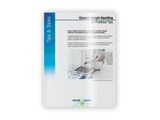To use all functions of this page, please activate cookies in your browser.
my.bionity.com
With an accout for my.bionity.com you can always see everything at a glance – and you can configure your own website and individual newsletter.
- My watch list
- My saved searches
- My saved topics
- My newsletter
Muscle
Muscle (from Latin musculus, diminutive of mus "mouse"[1]) is contractile tissue of the body and is derived from the mesodermal layer of embryonic germ cells. It is classified as skeletal, cardiac, or smooth muscle[2], and its function is to produce force and cause motion, either locomotion or movement within internal organs. Much of muscle contraction occurs without conscious thought and is necessary for survival, like the contraction of the heart, or peristalsis (which pushes food through the digestive system). Voluntary muscle contraction is used to move the body, and can be finely controlled, like movements of the eye, or gross movements like the quadriceps muscle of the thigh. There are two broad types of voluntary muscle fibers, slow twitch and fast twitch. Slow twitch fibers contract for long periods of time but with little force while fast twitch fibers contract quickly and powerfully but fatigue very rapidly. Additional recommended knowledge
TypesThere are three types of muscle:
Cardiac and skeletal muscles are "striated" in that they contain sarcomeres and are packed into highly-regular arrangements of bundles; smooth muscle has neither. While skeletal muscles are arranged in regular, parallel bundles, cardiac muscle connects at branching, irregular angles (called intercalated discs). Striated muscle contracts and relaxes in short, intense bursts, whereas smooth muscle sustains longer or even near-permanent contractions. Skeletal muscle is further divided into several subtypes:
AnatomyThe anatomy of muscles includes both gross anatomy, comprising all the muscles of an organism, and, on the other hand, microanatomy, which comprises the structures of a single muscle. Gross anatomy
One particularly important aspect of gross anatomy of muscles is pennation or lack thereof. In most muscles, all the fibers are oriented in the same direction, running in a line from the origin to the insertion. In pennate muscles, the individual fibers are oriented at an angle relative to the line of action, attaching to the origin and insertion tendons at each end. Because the contracting fibers are pulling at an angle to the overall action of the muscle, the change in length is smaller, but this same orientation allows for more fibers (thus more force) in a muscle of a given size. Pennate muscles are usually found where their length change is less important than maximum force, such as the rectus femoris. There are approximately 639 skeletal muscles in the human body. However, the exact number is difficult to define because different sources group muscles differently. Following are some major muscles[5] and their basic features:
MicroanatomyMuscle is mainly composed of muscle cells. Within the cells are myofibrils; myofibrils contain sarcomeres, which are composed of actin and myosin. Individual muscle fibres are surrounded by endomysium. Muscle fibers are bound together by perimysium into bundles called fascicles; the bundles are then grouped together to form muscle, which is enclosed in a sheath of epimysium. Muscle spindles are distributed throughout the muscles and provide sensory feedback information to the central nervous system. Skeletal muscle is muscle attached to skeletal tissue, distinct from heart or smooth muscle. It is arranged in discrete muscles, an example of which is the biceps brachii. It is connected by tendons to processes of the skeleton. In contrast, smooth muscle occurs at various scales in almost every organ, from the skin (in which it controls erection of body hair) to the blood vessels and digestive tract (in which it controls the caliber of the lumen and peristalsis). Cardiac muscle is the muscle tissue of the heart, and is similar to skeletal muscle in both composition and action, being comprised of myofibrils of sarcomeres. Cardiac muscle is anatomically different in that the muscle fibers are typically branched like a tree branch, and connect to other cardiac muscle fibers through intercalcated discs, and form the appearance of a syncytium. PhysiologyThe three (skeletal, cardiac and smooth) types of muscle have significant differences. However, all three use the movement of actin against myosin to create contraction. In skeletal mucscle, contraction is stimulated by electrical impulses transmitted by the nerves, the motor nerves and motoneurons in particular. Cardiac and smooth muscle contractions are stimulated by internal pacemaker cells which regularly contract, and propagate contractions to other muscle cells they are in contact with. All skeletal muscle and many smooth muscle contractions are facilitated by the neurotransmitter acetylcholine. Muscular activity accounts for much of the body's energy consumption. All muscle cells produce adenosine triphosphate (ATP) molecules which are used to power the movement of the myosin heads. Muscles conserve energy in the form of creatine phosphate which is generated from ATP and can regenerate ATP when needed with creatine kinase. Muscles also keep a storage form of glucose in the form of glycogen. Glycogen can be rapidly converted to glucose when energy is required for sustained, powerful contractions. Within the voluntary skeletal muscles, the glucose molecule can be metabolized anaerobically in a process called glycolysis which produces two ATP and two lactic acid molecules in the process (note that in aerobic conditions, lactate is not formed; instead NADH is formed and transmitted through the citric acid cycle). Muscle cells also contain globules of fat, which are used for energy during aerobic exercise. The aerobic energy systems take longer to produce the ATP and reach peak efficiency, and requires many more biochemical steps, but produces significantly more ATP than anaerobic glycolysis. Cardiac muscle on the other hand, can readily consume any of the three macronutrients (protein, glucose and fat) aerobically without a 'warm up' period and always extracts the maximum ATP yield from any molecule involved. The heart, liver and red blood cells will also consume lactic acid produced and excreted by skeletal muscles during exercise. Nervous controlEfferent legThe efferent leg of the peripheral nervous system is responsible for conveying commands to the muscles and glands, and is ultimately responsible for voluntary movement. Nerves move muscles in response to voluntary and autonomic (involuntary) signals from the brain. Deep muscles, superficial muscles, muscles of the face and internal muscles all correspond with dedicated regions in the primary motor cortex of the brain, directly anterior to the central sulcus that divides the frontal and parietal lobes. In addition, muscles react to reflexive nerve stimuli that do not always send signals all the way to the brain. In this case, the signal from the afferent fiber does not reach the brain, but produces the reflexive movement by direct connections with the efferent nerves in the spine. However, the majority of muscle activity is volitional, and the result of complex interactions between various areas of the brain. Nerves that control skeletal muscles in mammals correspond with neuron groups along the primary motor cortex of the brain's cerebral cortex. Commands are routed though the basal ganglia and are modified by input from the cerebellum before being relayed through the pyramidal tract to the spinal cord and from there to the motor end plate at the muscles. Along the way, feedback, such as that of the extrapyramidal system contribute signals to influence muscle tone and response. Deeper muscles such as those involved in posture often are controlled from nuclei in the brain stem and basal ganglia. Afferent legThe afferent leg of the peripheral nervous system is responsible for conveying sensory information to the brain, primarily from the sense organs like the skin. In the muscles, the muscle spindles convey information about the degree of muscle length and stretch to the central nervous system to assist in maintaining posture and joint position. The sense of where our bodies are in space is called proprioception, the perception of body awareness. More easily demonstrated than explained, proprioception is the "unconscious" awareness of where the various regions of the body are located at any one time. This can be demonstrated by anyone closing their eyes and waving their hand around. Assuming proper proprioceptive function, at no time will the person lose awareness of where the hand actually is, even though it is not being detected by any of the other senses. Several areas in the brain coordinate movement and position with the feedback information gained from proprioception. The cerebellum and red nucleus in particular continuously sample position against movement and make minor corrections to assure smooth motion. Role in health and diseaseExerciseExercise is often recommended as a means of improving motor skills, fitness, muscle and bone strength, and joint function. Exercise has several effects upon muscles, connective tissue, bone, and the nerves that stimulate the muscles. Various exercises require a predominance of certain muscle fiber utilization over another. Aerobic exercise involves long, low levels of exertion in which the muscles are used at well below their maximal contraction strength for long periods of time (the most classic example being the marathon). Aerobic events, which rely primarily on the aerobic (with oxygen) system, use a higher percentage of Type I (or slow-twitch) muscle fibers, consume a mixture of fat, protein and carbohydrates for energy, consume large amounts of oxygen and produce little lactic acid. Anaerobic exercise involves short bursts of higher intensity contractions at a much greater percentage of their maximum contraction strength. Examples of anaerobic exercise include sprinting and weight lifting. The anaerobic energy delivery system uses predominantly Type II or fast-twitch muscle fibers, relies mainly on ATP or glucose for fuel, consumes relatively little oxygen, protein and fat, produces large amounts of lactic acid and can not be sustained for as long a period as aerobic exercise. The presence of lactic acid has an inhibitory effect on ATP generation within the muscle; though not producing fatigue, it can inhibit or even stop performance if the intracellular concentration becomes too high. However, long-term training causes neovascularization within the muscle, increasing the ability to move waste products out of the muscles and maintain contraction. Once moved out of muscles with high concentrations within the sarcomere, lactic acid can be used by other muscles or body tissues as a source of energy, or transported to the liver where it is converted back to pyruvate. The ability of the body to export lactic acid and use it as a source of energy depends on training level. Humans are genetically predisposed with a larger percentage of one type of muscle group over another. An individual born with a greater percentage of Type I muscle fibers would theoretically be more suited to endurance events, such as triathlons, distance running, and long cycling events, whereas a human born with a greater percentage of Type II muscle fibers would be more likely to excel at anaerobic events such as a 200 meter dash, or weightlifting. People with high overall musculation and balanced muscle type percentage engage in sports such as rugby or boxing and often engage in other sports to increase their performance in the former.[citations needed] Delayed onset muscle soreness is pain or discomfort that may be felt one to three days after exercising and subsides generally within two to three days later. Once thought to be caused by lactic acid buildup, a more recent theory is that it is caused by tiny tears in the muscle fibres caused by eccentric contraction, or unaccustomed training levels. Since lactic acid disperses fairly rapidly, it could not explain pain experienced days after exercise.[6] DiseaseSymptoms of muscle diseases may include weakness, spasticity, myoclonus and myalgia. Diagnostic procedures that may reveal muscular disorders include testing creatine kinase levels in the blood and electromyography (measuring electrical activity in muscles). In some cases, muscle biopsy may be done to identify a myopathy, as well as genetic testing to identify DNA abnormalities associated with specific myopathies and dystrophies. Neuromuscular diseases are those that affect the muscles and/or their nervous control. In general, problems with nervous control can cause spasticity or paralysis, depending on the location and nature of the problem. A large proportion of neurological disorders leads to problems with movement, ranging from cerebrovascular accident (stroke) and Parkinson's disease to Creutzfeldt-Jakob disease. A non-invasive elastography technique that measures muscle noise is undergoing experimentation to provide a way of monitoring neuromuscular disease. The sound produced by a muscle comes from the shortening of actomyosin filaments along the axis of the muscle. During contraction, the muscle shortens along its longitudinal axis and expands across the transverse axis, producing vibrations at the surface.[7] AtrophyThere are many diseases and conditions which cause a decrease in muscle mass, known as muscle atrophy. Example include cancer and AIDS, which induce a body wasting syndrome called cachexia. Other syndromes or conditions which can induce skeletal muscle atrophy are congestive heart disease and some diseases of the liver. During aging, there is a gradual decrease in the ability to maintain skeletal muscle function and mass, known as sarcopenia. The exact cause of sarcopenia is unknown, but it may be due to a combination of the gradual failure in the "satellite cells" which help to regenerate skeletal muscle fibers, and a decrease in sensitivity to or the availability of critical secreted growth factors which are necessary to maintain muscle mass and satellite cell survival. Sarcopenia is a normal aspect of aging, and is not actually a disease state. StrengthA display of "strength" (e.g lifting a weight) is a result of three factors that overlap; Physiological strength (muscle size, cross sectional area, available crossbridging, responses to training), neurological strength (how strong or weak is the signal that tells the muscle to contract), and mechanical strength (muscle's force angle on the lever, moment arm length, joint capabilities). Contrary to popular belief, the number of muscle fibres cannot be increased through exercise; instead the muscle cells simply get bigger. Muscle fibres have a limited capacity for growth through hypertrophy and some believe they split through hyperplasia if subject to increased demand. The 'strongest' human muscleSince three factors affect muscular strength simultaneously and muscles never work individually, it is unrealistic to compare strength in individual muscles, and state that one is the "strongest". Accordingly, no one muscle can be named 'the strongest', but below are several muscles whose strength is noteworthy for different reasons.
EfficiencyThe efficiency of human muscle has been measured (in the context of rowing and cycling) at 14% to 27%. The efficiency is defined as the ratio of mechanical work output to the total metabolic cost. Body buildingBodybuilding is the process of maximizing muscle hypertrophy through the combination of weight training, sufficient caloric intake, and rest - often utilising extraneous hormones. Someone who engages in this activity is referred to as a bodybuilder. The muscles are revealed through a combination of fat loss, oils, and tanning (or tanning lotions) which combined with lighting make the definition of the muscle group more distinct. Muscle evolutionEvolutionarily, specialized forms of skeletal and cardiac muscles predated the divergence of the vertebrate/arthropod evolutionary line.[8] This indicates that these types of muscle developed in a common ancestor sometime before 700 million years ago (mya). Vertebrate smooth muscle (smooth muscle found in humans) was found to have evolved independently from the skeletal and cardiac muscles. References
Notes
See also
Categories: Muscular system | Tissues | Exercise physiology |
|||||||||||||||||||||||||||||||||||||||||||||||||||||||||||||||||||||||||||||||||||||||||||||||||||||||||||||||||||||||||||||||||||||||||||||||||||||||||||||||||||||||||||||||||||||||||||||||||||||||||||||||||||||||||||||||||||||||||||||||||||||||||||||||||||||||||||||||||||||||||||||||||||||||||||||||||||||||||
| This article is licensed under the GNU Free Documentation License. It uses material from the Wikipedia article "Muscle". A list of authors is available in Wikipedia. | |||||||||||||||||||||||||||||||||||||||||||||||||||||||||||||||||||||||||||||||||||||||||||||||||||||||||||||||||||||||||||||||||||||||||||||||||||||||||||||||||||||||||||||||||||||||||||||||||||||||||||||||||||||||||||||||||||||||||||||||||||||||||||||||||||||||||||||||||||||||||||||||||||||||||||||||||||||||||
- House_Ear_Institute
- DNA
- Adulterated animal-based foods to become easier to detect in future
- Nominated for the “Great Award of Medium-Sized Businesses”: Schwarzer Precision from Essen - The manufacturers of micro pumps for medical and environmental application convince with family feeling, innovation and commitment
- Edward_Treacher_Collins







